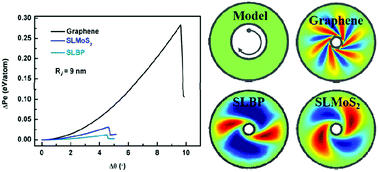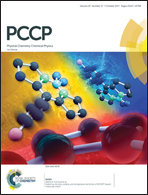Circular torsion induced fan-blade shaped wrinkling in two-dimensional nano-rings
Abstract
Molecular dynamics (MD) simulations are conducted to study the deformation behavior and strain distribution in two-dimensional (2D) nano-rings of graphene, single-layer black phosphorus (SLBP) and single-layer MoS2 (SLMoS2) under circular torsion. Interestingly, fan-blade shaped wrinkling is generated, in which the maximum torsion angle (Δθ) and the potential energy change per atom (ΔPe) increase with increasing inner radius but decrease with increasing temperature. As the inner radius is increased, the wave number of wrinkling increases but the wave amplitude decreases. The geometrical characteristics of wrinkling are closely related to the intrinsic elastic modulus (E) and Poisson's ratio (ν). Specifically, the graphene nano-rings possess the largest Δθ and ΔPe but the smallest wave amplitude, while the SLBP nano-rings exhibit the smallest Δθ and ΔPe but the largest wave amplitude. Furthermore, the strongly anisotropic E and ν values of SLBP result in orientation-dependent geometrical characteristics of wrinkles, and fan-blade shaped wrinkling with a strain vortex is induced, which might substantially enhance the pseudomagnetic fields and optical funnel effect for the separation of photon-induced electron–hole pairs, and thus be exploited to improve the photoelectric properties of 2D materials.



 Please wait while we load your content...
Please wait while we load your content...